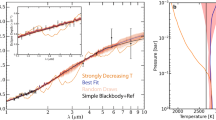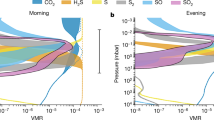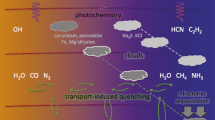Abstract
Currently, the strongest remotely detectable biosignature in the Earth’s atmosphere is molecular oxygen (O2) produced during photosynthesis. However, recent studies of geochemical signatures on Earth-like exoplanets suggest that for most of them, atmospheric O2 would not be detectable by a remote observer, except during the last ~500 Myr of evolution. During a long period in the Earth’s history (2.0–0.7 Gyr ago), O2 was likely present in the atmosphere but in low concentrations, estimated at ~0.1–1% of the current level. Although spectral manifestations of O2 are weak at such low concentrations; however, ozone (O3) molecules, which are in a photochemical equilibrium with such low O2 concentrations, cause noticeable spectral features in the Hartley–Huggins UV band (~0.25 µm), with a weaker manifestation in the medium IR-region at about 9.7 µm. Thus, taking the Earth’s history as an informative example (proxy), it can be concluded that a category of exoplanets may exist for which the ordinary atmospheric biosignature can only be identified in the UV range. Accordingly, the article emphasizes the importance of planning for UV observation capabilities when designing future space telescopes for direct observations of exoplanets and their atmospheres, such as the World Space Observatory-UV (WSO-UV), Habitable Exoplanet Observatory (HabEx), or Large UV/Optical/Infrared Surveyor (LUVOIR), for the detection of ozone O3 in the atmospheres of planets with intermediate oxidation states. The article also discusses mitigation strategies for the so-called false positives, i.e., detection of O3 generated in abiotic processes. It also emphasizes the importance and broad implications of studying the Earth’s history as a window to understanding potential biosignatures for exoplanets and the importance of UV observations for identifying habitable exoplanets with next-generation space telescopes.


Similar content being viewed by others
Change history
18 February 2020
An Erratum to this paper has been published: https://doi.org/10.1134/S003809461908001X
REFERENCES
Abe, Y., Abe-Ouchi, A., Sleep, N.H., and Zahnle, K.J., Habitable zone limits for dry planets, Astrobiology, 2011, vol. 11, pp. 443–460.
Airapetian, V.S., Glocer, A., Khazanov, G. V., Loyd, R.O.P., France, K., Sojka, J., Danchi, W.C., and Liemohn, M.W., How hospitable are space weather affected habitable zones? The role of ion escape, Astrophys. J., 2017, vol. 836, pp. L3–L8.
Anglada-Escude, G., Amado, P.J., Barnes, J., Berdinas, Z.M., Butler, R.P., Coleman, G.A.L., de la Cueva, I., Dreizler, S., Endl, M., Giesers, B., Jeffers, S.V., Jenkins, J.S., Jones, H.R.A., Kiraga, M., Kuerster, M., et al., A terrestrial planet candidate in a temperate orbit around Proxima Centauri, Nature, 2016, vol. 536, pp. 437–440.
Arney, G., Domagal-Goldman, S.D., Meadows, V.S., Wolf, E.T., Schwieterman, E., Charnay, B., Claire, M., Hebrard, E., and Trainer, M.G., The pale orange dot: the spectrum and habitability of hazy Archean Earth, Astrobiology, 2016, vol. 16, pp. 873–899.
Batalha, N.M., Exploring exoplanet populations with NASA’s Kepler mission, Proc. Natl. Acad. Sci. U.S.A., 2014, vol. 111, pp. 12 647–12 654.
Bisikalo, D.V., Shematovich, V.I., Cherenkov, A.A., Fossati, L., and Moestl, C., Atmospheric mass loss from hot Jupiter irradiated by stellar superflares, Astrophys. J., 2018, vol. 869, p. 108.
Bolcar, M.R., Aloezos, S., Bly, V.T., Collins, C., Crooke, J., Dressing, C.D., Fantano, L., Feinberg, L.D., France, K., Gochar, G., Gong, Q., Hylan, J.E., Jones, A., Linares, I., Postman, M., et al., The Large UV/Optical/Infrared Surveyor (LUVOIR): decadal mission concept design update, Proc. SPIE, 2017, vol. 10 398, art. ID 1039809.
Bolmont, E., Gallet, F., Mathis, S., Charbonnel, C., Amard, L., and Alibert, Y., Tidal dissipation in rotating low-mass stars and implications for the orbital evolution of close-in massive planets, Astron. Astrophys., 2017, vol. 604, p. A113.
Boyarchuk, A.A., Shustov, B.M., Savanov, I.S., Sachkov, M.E., Bisikalo, D.V., Mashonkina, L.I., Wiebe, D.Z., Shematovich, V.I., Shchekinov, Yu.A., Ryabchikova, T.A., Chugai, N.N., Ivanov, P.B., Voshchinnikov, N.V., Gomez de Castro, A.I., Lamzin, S.A., et al., Scientific problems addressed by the Spektr-UV space project (world space Observatory—Ultraviolet), Astron. Rep., 2016, vol. 60, no. 1, pp. 1–42.
Catling, D.C., Krissansen-Totton, J., Kiang, N.Y., Crisp, D., Robinson, T.D., DasSarma, S., Rushby, A.J., Del Genio, A., Bains, W., and Domagal-Goldman, S., Exoplanet biosignatures: a framework for their assessment, Astrobiology, 2018, vol. 18, pp. 709–738.
Claire, M., Catling, D., and Zahnle, K., Biogeochemical modeling of the rise in atmospheric oxygen, Geobiology, 2006, vol. 4, pp. 239–269.
Cole, D.B., Reinhard, C.T., Wang, X., Gueguen, B., Halverson, G.P., Gibson, T., Hodgskiss, M.S., McKenzie, N.R., Lyons, T.W., and Planavsky, N.J., A shale-hosted Cr isotope record of low atmospheric oxygen during the Proterozoic, Geology, 2016, vol. 44, pp. 555–558.
Davenport, J.R.A., Kipping, D.M., Sasselov, D., Matthews, J.M., and Cameron, C., MOST observations of our nearest neighbor: flares on Proxima Centauri, Astrophys. J., 2016, vol. 829, pp. L31–L36.
Des Marais, D.J., Harwit, M.O., Jucks, K.W., Kasting, J.F., Lin, D.N.C., Lunine, J.I., Schneider, J., Seager, S., Traub, W.A., and Woolf, N.J., Remote sensing of planetary properties and biosignatures on extrasolar terrestrial planets, Astrobiology, 2002, vol. 2, pp. 153–181.
Dittmann, J.A., Irwin, J.M., Charbonneau, D., Bonfils, X., Astudillo-Defru, N., Haywood, R.D., Berta-Thompson, Z.K., Newton, E.R., Rodriguez, J.E., Winters, J.G., Tan, T., Almenara, J., Bouchy, F., Delfosse, X., Forveille, T., et al., A temperate rocky super-Earth transiting a nearby cool star, Nature, 2017, vol. 544, pp. 333–336.
Domagal-Goldman, S.D., Segura, A., Claire, M.W., Robinson, T.D., and Meadows, V.S., Abiotic ozone and oxygen in atmospheres similar to prebiotic Earth, Astrophys. J., 2014, vol. 792, art. ID 90.
Driscoll, P. and Barnes, R., Tidal heating of earth-like exoplanets around m stars: thermal, magnetic, and orbital evolutions, Astrobiology, 2015, vol. 15, pp. 739–760.
Farquhar, J., Savarino, J., Airieau, S., and Thiemens, M.H., Observation of wavelength-sensitive mass independent sulfur isotope effects during SO2 photolysis: implications for the early atmosphere, J. Geophys. Res.: Planets, 2001, vol. 106, pp. 829–839.
France, K., Loyd, R.O.P., Youngblood, A., Brown, A., Schneider, P.C., Hawley, S.L., Froning, C.S., Linsky, J.L., Roberge, A., Buccino, A.P., Davenport, J.R.A., Fontenla, J.M., Kaltenegger, L., Kowalski, A.F., Mauas, P.J.D., et al., The MUSCLES treasury survey. I. Motivation and overview, Astrophys. J., 2016, vol. 820, art. ID 89.
Fossati, L., Bisikalo, D., Lammer, H., Shustov, B., and Sachkov, M., Major prospects of exoplanet astronomy with the World Space Observatory–UltraViolet mission, Astrophys. Space Sci., 2014, vol. 354, pp. 9–19.
Fujii, Y., Angerhausen, D., Deitrick, R., Domagal-Goldman, S.D., Grenfell, J.L., Hori, Y., Kane, S.R., Pallé, E., Rauer, H., Siegler, N., Stapelfeldt, K., and Stevenson, B., Exoplanet biosignatures: observational prospects, Astrobiology, 2018, vol. 18, pp. 739–778.
Gaudi, B.S., Mennesson, B., Seager, S., Cahoy, K., Clarke, J., Domagal-Goldman, S., Feinberg, L., Guyon, O., Kasdin, J., Marois, C., Mawet, D., Tamura, M., Mouillet, D., Prusti, T., Quirrenbach, A., et al., The Habitable Exoplanet Observatory (HabEx), Proc. SPIE, 2018, vol. 10 698, art. ID 106980P.
Gillon, M., Triaud, A.H.M.J., Demory, B.-O., Jehin, E., Agol, E., Deck, K.M., Lederer, S.M., de Wit, J., Burdanov, A., Ingalls, J.G., Bolmont, E., Leconte, J., Raymond, S.N., Selsis, F., Turbet, M., et al., Seven temperate terrestrial planets around the nearby ultracool dwarf star TRAPPIST-1, Nature, 2017, vol. 542, pp. 456–460.
Haqq-Misra, J., Kopparapu, R.K., Batalha, N.E., Harman, C.E., and Kasting, J.F., Limit cycles can reduce the width of the Habitable Zone, Astrophys. J., 2016, vol. 827, p. 120.
Kane, S.R., Hill, M.L., Kasting, J.F., Kopparapu, R.K., Quintana, E.V., Barclay, T., Batalha, N.M., Borucki, W.J., Ciardi, D.R., Haghighipour, N., Hinkel, N.R., Kaltenegger, L., Selsis, F., and Torres, G., A catalog of Kepler Habitable Zone exoplanet candidates, Astrophys. J., 2016, vol. 830, no. 1.
Kasting, J.F. and Donahue, T.M., The evolution of atmospheric ozone, J. Geophys. Res.: Oceans, 1980, vol. 85, pp. 3255–3263.
Kasting, J.F., Whitmire, D.P., and Reynolds, R.T., Habitable zones around main sequence stars, Icarus, 1993, vol. 101, pp. 108–128.
Kasting, J.F., Kopparapu, R., Ramirez, R.M., and Harman, C.E., Remote life-detection criteria, habitable zone boundaries, and the frequency of Earth-like planets around M and late K stars, Proc. Natl. Acad. Sci. U.S.A., 2013, vol. 111, pp. 1–6.
Kawahara, H., Matsuo, T., Takami, M., Fujii, Y., Kotani, T., Murakami, N., Tamura, M., and Guyon, O., Can ground-based telescopes detect the oxygen 1.27 mm absorption feature as a biomarker in exoplanets? Astrophys. J., 2012, vol. 758, p. 13.
Kopparapu, R.K., Ramirez, R., Kasting, J.F., Eymet, V., Robinson, T.D., Mahadevan, S., Terrien, R.C., Domagal-Goldman, S., Meadows, V., and Deshpande, R., Habitable zones around main-sequence stars: new estimates, Astrophys. J., 2013, vol. 765, p. 131.
Kopparapu, R.K., Ramirez, R.M., Schotte-Kotte, J., Kasting, J.F., Domagal-Goldman, S., and Eymet, V., Habitable zones around main-sequence stars: dependence on planetary mass, Astrophys. J., 2014, vol. 787, pp. L29–L33.
Kopparapu, R.K., Wolf, E.T., Haqq-Misra, J., Yang, J., Kasting, J.F., Meadows, V., Terrien, R., and Mahadevan, S., The inner edge of the habitable zone for synchronously rotating planets around low-mass stars using general circulation models, Astrophys. J., 2016, vol. 819, p. 84.
Kulikov, Yu.N., Lammer, H., Lichtenegger, H.I.M., Penz, T., Breuer, D., Spohn, T., Lundin, R., and Biernat, H.K., A comparative study of the influence of the active young Sun on the early atmospheres of Earth, Venus, and Mars, Space Sci. Rev., 2007, vol. 129, pp. 207–243.
Lammer, H., Origin and Evolution of Planetary Atmospheres: Implications for Habitability. Springer Briefs in Astronomy, Berlin: Springer-Verlag, 2013.
Lammer, H., Bredehöft, J.H., Coustenis, A., Khodachenko, M.L., Kaltenegger, L., Grasset, O., Prieur, D., Raulin, F., Ehrenfreund, P., Yamauchi, M., Wahlund, J.-E., Grießmeier, J.-M., Stangl, G., Cockell, C.S., Kulikov, Y.N., et al., What makes a planet habitable? Astron. Astrophys. Rev., 2009, vol. 17, pp. 181–249.
Lissauer, J., Jontof-Hutter, D., Rowe, J., Fabrycky, D.C., Lopez, E.D., Agol, E., Marcy, G.W., Deck, K.M., Fischer, D.A., Fortney, J.J., Howell, S.B., Isaacson, H., Jenkins, J.M., Kolbl, R., Sasselov, D., et al., All six planets known to orbit Kepler-11 have low densities, Astrophys. J., 2013, vol. 770, pp. 1–15.
Lovis, C., Snellen, I., Mouillet, D., Pepe, F., Wildi, F., Astudillo-Defru, N., Beuzit, J.-L., Bonfils, X., Cheetham, A., Conod, U., Delfosse, X., Ehrenreich, D., Figueira, P., Forveille, T., Martins, J.H.C., et al., Atmospheric characterization of Proxima b by coupling the SPHERE high contrast imager to the ESPRESSO spectrograph, Astron. Astrophys., 2016, vol. 599, p. A16.
Luger, R. and Barnes, R., Extreme water loss and abiotic O2 buildup on planets throughout the habitable zones of M dwarfs, Astrobiology, 2015, vol. 15, pp. 119–143.
Luger, R., Barnes, R., Lopez, E., Fortney, J., Jackson, B., and Meadows, V., Habitable evaporated cores: Transforming mini-Neptunes into super-Earths in the habitable zones of M dwarfs, Astrobiology, 2015, vol. 15, pp. 57–88.
Luo, G., Ono, S., Beukes, N.J., Wang, D.T., Xie, S., and Summons, R.E., Rapid oxygenation of Earth’s atmosphere 2.33 billion years ago, Sci. Adv., 2016, vol. 2, pp. e1600134–e1600134.
Lyons, T.W., Reinhard, C.T., and Planavsky, N.J., The rise of oxygen in Earth’s early ocean and atmosphere, Nature, 2014, vol. 506, pp. 307–315.
Meadows, V.S., Reflections on O2 as a biosignature in exoplanetary atmospheres, Astrobiology, 2017, vol. 17, pp. 1022–1052.
Meadows, V.S., Reinhard, C.T., Arney, G.N., Parenteau, M.N., Schwieterman, E.W., Domagal-Goldman, S.D., Lincowski, A.P., Stapelfeldt, K.R., Rauer, H., DasSarma, S., Hegde, S., Narita, N., Deitrick, R., Lustig-Yaeger, J., Lyons, T.W., et al., Understanding oxygen as a biosignature in the context of its environment, Astrobiology, 2018, vol. 18, pp. 630–662.
Mennesson, B., Gaudi, S., Seager, S., Cahoy, K., Domagal-Goldman, S., Feinberg, L., Guyon, O., Kasdin, J., Marois, C., Mawet, D., Tamura, M., Mouillet, D., Prusti, T., Quirrenbach, A., Robinson, T., et al., The Habitable Exoplanet (HabEx) Imaging Mission: preliminary science drivers and technical requirements, Proc. SPIE, 2016, vol. 99 040.
Morton, T.D., Bryson, S.T., Coughlin, J.L., Rowe, J.F., Ravichandran, G., Petigura, E.A., Haas, M.R., and Batalha, N.M., False positive probabilities for all Kepler objects of interest: 1284 newly validated planets and 428 likely false positives, Astrophys. J., 2016, vol. 822, p. 86.
Noack, L., Honing, D., Rivoldini, A., Heistracher, C., Zimov, N., Journaux, B., Lammer, H., van Hoolst, T., and Bredehöft, J.H., Water-rich planets: How habitable is a water layer deeper than on Earth? Icarus, 2016, vol. 277, pp. 215–236.
Panchuk, V.E., Klochkova, V.G., Sachkov, M.E., and Yushkin, M.V., Doppler methods of search and monitoring of exoplanets, Sol. Syst. Res., 2015, vol. 49, pp. 420–429.
Paradise, A. and Menou, K., GCM simulations of unstable climates in the habitable zone, Astrophys. J., 2017, vol. 848, art. ID 33.
Pavlov, A.A. and Kasting, J.F., Mass-independent fractionation of sulfur isotopes in Archean sediments: strong evidence for an anoxic Archean atmosphere, Astrobiology, 2002, vol. 2, pp. 27–41.
Pierrehumbert, R. and Gaidos, E., Hydrogen greenhouse planets beyond the habitable zone, Astrophys. J. Lett., 2011, vol. 734, pp. L13–L17.
Planavsky, N.J., Reinhard, C.T., Wang, X., Thomson, D., Mcgoldrick, P., Rainbird, R.H., Johnson, T., Fischer, W.W., and Lyons, T.W., Low mid-proterozoic atmospheric oxygen levels and the delayed rise of animals, Science, 2014, vol. 346, pp. 635–638.
Ranjan, S., Wordsworth, R.D., and Sasselov, D.D., The surface UV environment on planets orbiting M dwarfs: implications for prebiotic chemistry and the need for experimental follow-up, Astrophys. J., 2017, vol. 843, p. 110.
Reinhard, C.T., Olson, S.L., Schwieterman, E.W., and Lyons, T.W., False negatives for remote life detection on ocean-bearing planets: lessons from the early earth, Astrobiology, 2017, vol. 17, pp. 287–297.
Ribas, I., Bolmont, E., Selsis, F., Reiners, A., Leconte, J., Raymond, S.N., Engle, S.G., Guinan, E.F., Morin, J., Turbet, M., Forget, F., and Anglada-Escude, G., The habitability of Proxima Centauri b, Astron. Astrophys., 2016, vol. 596, p. A111.
Robinson, T.D., Ennico, K., Meadows, V.S., Sparks, W., Bussey, D.B.J., Schwieterman, E.W., and Breiner, J., Detection of ocean glint and ozone absorption using LCROSS Earth Observations, Astrophys. J., 2014, vol. 787, p. 171.
Robinson, T.D., Stapelfeldt, K.R., and Marley, M.S., Characterizing rocky and gaseous exoplanets with 2 m class space-based coronagraphs, Publ. Astron. Soc. Pac., 2016, vol. 128, p. 025003.
Sachkov, M., Shustov, B., and Gómez de Castro, A.I., Instrumentation of the WSO-UV project, Proc. SPIE, 2014, vol. 9144, p. 914 402.
Sachkov, M., Panchuk, V., Yushkin, M., and Fatkhullin, T., Optical design of WUVS instrument: WSO–UV spectrographs, Proc. SPIE, 2016, vol. 9905, p. 990 537.
Schwieterman, E.W., Meadows, V.S., Domagal-Goldman, S.D., Deming, D., Arney, G.N., Luger, R., Harman, C.E., Misra, A., and Barnes, R., Identifying planetary biosignature impostors: spectral features of CO and O4 resulting from abiotic O2/O3 production, Astrophys. J., 2016, vol. 819, pp. L13–L17.
Schwieterman, E., Kiang, N., Parenteau, M., Harman, C.E., DasSarma, S., Fisher, T.M., Arney, G.N., Hartnett, H.E., Reinhard, C.T., Olson, S.L. Meadows, V.S., Cockell, C.S., Walker, S.I., Grenfell, J.L., Hegde, S., et al., Exoplanet biosignatures: a review of remotely detectable signs of life, Astrobiology, 2018, vol. 18, pp. 663–708.
Seager, S., Exoplanet habitability, Science, 2013, vol. 340, pp. 577–581.
Seager, S., Turnbull, M., Sparks, W., Thomson, M., Shaklan, S.B., Roberge, A., Kuchner, M., Kasdin, N.J., Domagal-Goldman, S., Cash, W., Warfield, K., Lisman, D., Scharf, D., Webb, D., Trabert, R., et al., The Exo-S probe class starshade mission, Proc. SPIE, 2015, vol. 9605, p. 96050W
Segura, A., Krelove, K., Kasting, J.F., Sommerlatt, D., Meadows, V., Crisp, D., Cohen, M., and Mlawer, E., Ozone concentrations and ultraviolet fluxes on Earth-like planets around other stars, Astrobiology, 2003, vol. 3, pp. 689–708.
Shields, A.L., Bitz, C.M., Meadows, V.S., Joshi, M.M., and Robinson, T.D., Spectrum-driven planetary deglaciation due to increases in stellar luminosity, Astrophys. J., 2014, vol. 785, pp. L9–L12.
Shields, A.L., Ballard, S., and Johnson, J.A., The habitability of planets orbiting M-dwarf stars, Phys. Rep., 2016, vol. 663, pp. 1–38.
Stark, C.C., Roberge, A., Mandell, A., and Robinson, T.D., Maximizing the ExoEarth candidate yield from a future direct imaging mission, Astrophys. J., 2014, vol. 795, p. 122.
Stevenson, D., Life-sustaining planets in interstellar space? Nature, 1999, vol. 400, p. 32.
Stevenson, K.B., Lewis, N.K., Bean, J.L., Beichman, C., Fraine, J., Kilpatrick, B.M., Krick, J.E., Lothringer, J.D., Mandell, A.M., Valenti, J.A., Agol, E., Angerhausen, D., Barstow, J.K., Birkmann, S.M., Burrows, A., et al., Transiting exoplanet studies and community targets for JWST’s Early Release Science Program, Publ. Astron. Soc. Pac., 2016, vol. 128, p. 94 401.
Tavrov, A., Kameda, S., Yudaev, A., Dzyuban, I., Kiselev, A. Shashkova, I., Korablev, O., Sachkov, M., Nishikawa, J., Tamura, M., Go, M., Keigo, E., Ikoma, M., and Narita, N., Stellar imaging coronagraph and exoplanet coronal spectrometer: two additional instruments for exoplanet exploration onboard the WSO-UV 1.7-m orbital telescope, J. Astron. Telesc., Instrum., Syst., 2018, vol. 4, p. 044 001.
Tian, F., History of water loss and atmospheric O2 buildup on rocky exoplanets near M dwarfs, Earth Planet. Sci. Lett., 2015, vol. 432, pp. 126–132.
Walker, S.I., Bains, W., Cronin, L., DasSarma, S., Danielache, S., Domagal-Goldman, S., Kacar, B., Kiang, N.Y., Lenardic, A., Reinhard, C.T., Moore, W., Schwieterman, E.W., Shkolnik, E.L., and Smith H.B., Exoplanet biosignatures: future directions, Astrobiology, 2018, vol. 18, pp. 779–824.
Wolf, E.T., Assessing the habitability of the TRAPPIST-1 system using a 3D climate model, Astrophys. J., 2017, vol. 839, pp. L1–L9.
Wordsworth, R. and Pierrehumbert, R., Abiotic oxygen dominated atmospheres on terrestrial habitable zone planets, Astrophys. J., 2014, vol. 785, pp. L20–L24.
Yang, J., Cowan, N.B., and Abbot, D.S., Stabilizing cloud feedback dramatically expands the habitable zone of tidally locked planets, Astrophys. J. Lett., 2013, vol. 771, pp. L45–L49.
Yang, J., Boue, G., Fabrycky, D.C., and Abbot, D.S., Strong dependence of the inner edge of the habitable zone on planetary rotation rate, Astrophys. J., 2014, vol. 787, pp. L2–L6.
Zsom, A., Seager, S., de Wit, J., and Stamenkovic, V., Toward the minimum inner edge distance of the habitable zone, Astrophys. J., 2013, vol. 778, p. 109.
Funding
The work by V.I. Shematovich was supported by the Russian Foundation for Basic Research, project no. 18-02-00721, and by the Presidium of the Russian Academy of Sciences within Basic Research Program no. 28(KP19-270).
Author information
Authors and Affiliations
Corresponding author
Additional information
Translated by A. Kobkova
This article has been retracted. Please see the retraction notice for more detail:https://doi.org/10.1134/S003809461908001X
About this article
Cite this article
Sachkov, M.E., Shematovich, V.I. RETRACTED ARTICLE: Exoplanet Habitability: Potential O2/O3 Biosignatures in the Ultraviolet. Sol Syst Res 53, 322–331 (2019). https://doi.org/10.1134/S003809461905006X
Received:
Revised:
Accepted:
Published:
Issue Date:
DOI: https://doi.org/10.1134/S003809461905006X




